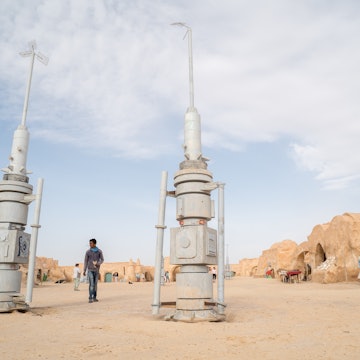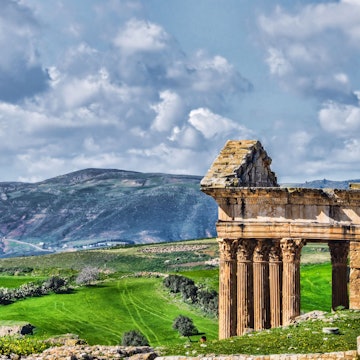

Berber architecture includes stacked structures like these vaulted rooms used for storing grain. Alison Lyons Photography / Getty Images
Tunisia's Berber community was largely ignored and silenced during the long years before the ouster of former president Ben Ali, but since the 2011 revolution, the culture and traditions of the area’s indigenous inhabitants have increasingly been in the spotlight thanks to the proliferation of Berber organisations working to promote their social and cultural heritage.
These groups have helped spark an earnest interest in Tamazight, the language of the Berbers (who call themselves Amazigh), as well as their unique cuisine, intricate handicrafts and fascinating architecture – not only among Tunisians eager to learn about their Berber origins, but also with visitors interested in exploring the country's cultural heritage.
Centuries-old Berber villages can be found along the length and breadth of Tunisia. As a strategy to defend themselves from invaders, Berber settlements were either either built on fortified mountaintops or dug into the ground in the form of troglodyte dwellings hidden in the rockface. Today the age-old stone buildings of many of these villages and towns are largely abandoned as their inhabitants have moved to newly built satellite towns of modern buildings.
Meanwhile, the otherworldly troglodyte dwellings and imposing ksour (the plural of ksar – a fortress-like building typical of Berber architecture) have been used as film sets in the immensely popular Star Wars series. Inevitably, silver-screen tourism brings busloads of tourists to the film locations, and the ancient stone buildings have been restored and transformed into guesthouses or museums, preserving the unique Berber architecture and heritage.
No matter where you visit in Tunisia, its Berber towns, sites and attractions will entice you to explore this fascinating culture and the traditions of its original inhabitants.
Central Tunisia: Take in the panoramic views from Takrouna and Kesra
Takrouna is probably the most visited of Tunisia's Berber villages, perhaps because it’s an easy trip from Tunis, at just 90km away. This almost entirely abandoned village is perched 200m above sea level on a narrow rocky outcrop. Reaching the top involves a demanding climb up a series of stairs, but the reward once you reach the top is a dazzling panorama of the waters of the Gulf of Hammamet to the east and the mountain of Djebel Zaghouan to the north. Towards the south, the alluvial plains of Kairouan are covered in neat geometrical rows of olive groves.
Take in the 180-degree views with a glass of hot mint tea from the terrace of Le Rocher Bleu, a rustic cafe of stone floors covered with vibrantly coloured Berber carpets. While you're there, have a peek at the small eco-museum next door (open only on request – ask at the cafe). Dar Gmach Museum is made up of two small rooms with a collection of examples Berber pottery, tools and other household objects.
The town of Kesra lies in the Tunisian interior atop a rocky mountain face reached via a winding road passing through a forest of Aleppo pines. At 966m, Kesra is the country’s highest Berber village. Not surprisingly, there are many stairs to climb to the top, but the steps painted in multicoloured stripes and decorated with letters from the Berber alphabet are a good distraction from the physical effort. In the heart of the old town is an old Byzantine fort transformed into the Museum of Traditional Heritage. Here you can see examples of Berber pottery and textiles, while informational panels share insights into traditional weaving and rituals performed at important life events like births, circumcision ceremonies, weddings and funerals.
Watch Guellala’s potters on the island of Djerba
Guellala is the only Berber town on the island of Djerba and is known for its earthenware pottery, which has been produced here for centuries. On the southern part of the island, Guellala used to be home to hundreds of potters, but today only a handful can be seen busy at work in their workshops. On a hill overlooking the town is Guellala Museum, a beautiful whitewashed building with a charming colonnaded courtyard filled with bougainvillea. The permanent exhibition includes a large collection of traditional tools and garments and everyday objects used in the past by the islanders. Also on display are life-size figures enacting scenes of everyday life like fishing, weaving and olive oil making but also wedding ceremonies.
Gateways to the Tunisian Sahara: Matmata, Tamezret and Toujane
Southwest of the coastal city of Gabes lies Matmata, perched on the edge of the Sahara desert at 600m and overlooking the Dahar Mountains. Matmata is famous for its troglodyte homes dug into the rock in a series of large pits interconnected with hidden passageways and open-air courtyards. This unique Berber building method protected its inhabitants from the scorching sun while retaining heat in the winter. A few Berber families open their homes to visitors (for a small donation). At Dar Taoufik on the road to Tamezret, you can explore the underground chambers, see traditional tools and earthenware pots, and taste the locally produced olive oil, honey and freshly baked tabouna bread.
Matmata is also one of south Tunisia's most popular destinations as the site of the film location of the first Star Wars movie. Hotel Sidi Driss was transformed into Luke Skywalker's home and today welcomes casual visitors as well as overnight guests in its basic rooms. Robot-like props used in the film stand as testaments in the hotel's courtyard, while a cave-like room is decorated with photographs of George Lucas, Mark Hamill and Harrison Ford taken during the shooting.

Nearby is Tamezret, a largely abandoned Berber town of crumbling stone houses of bright blue windows and doors. Underneath the compact hilltop town is a disused centuries-old series of horizontal and vertical tunnels that were once used for defensive purposes. Look out for the symbols of fish, a zigzag of three peaks or handprints painted or engraved on walls and above doorways. These Berber symbols actually have Christian origins. Mongi Bouras, the founder and curator of the town's Berber Museum, can show you examples of traditional jewellery, clothing and wedding costumes, as well as the hand-embroidered footwear he makes himself. If you're interested in exploring the local cuisine, ask him about the traditional Berber dinners he hosts.
Toujane, another lovely Berber village, is a 45-minute drive away. Most of the residents now live in Toujane Nouvelle, a new town of modern buildings. The old village is built on the edge of a hill overlooking a valley and is made up of walled compounds hiding inner courtyards with arched doorways. Peek through their gates and you may spot Berber women busy at their looms. Watch your step – pits in the ground on the periphery of the village reveal empty troglodyte homes. A few shops on the main road peddle colourful kilims and rugs, and the old olive mill is an example of the many traditional mills with stone presses once used to transform local olives into a pungent oil. Break out your hiking boots and head up the rocky path lined with thyme and rosemary to the ksar on the mountain top for 360-degree views of the Dahar Mountains in the distance.

Deep south: Saharan towns of Ksar Ouled Soltane, Douiret and Chenini
Tataouine is known by Star Wars fans as the town that inspired the name of Luke Skywalker's home, even though most of the desert scenes from Star Wars were shot in and around Matmata. The Berber town of Tataouine is actually the gateway to other popular destinations in the Sahara. Its most interesting attraction is its lively markets held every Monday and Thursday, but otherwise it's mostly used by travellers as a stepping stone to ksour country.
Head south for 24km to reach Ksar Ouled Soltane, one of the most popular attractions in the Tataouine district, thanks to its impressive and remarkably well-preserved ksar. What's outstanding about this ancient fortress-like structure is that it's a multi-level building rising up to four storeys with vaulted roofs and multiple courtyards connected with external stairways. On each storey of the fortified thick-walled ksar is a ghorfa, a compartment used to store valuable grains and food supplies safely away from potential thieves or looters. Star Wars fans will recognise the building as the slave quarters that were home to Anakin Skywalker in The Phantom Menace.
Southwest of Tataouine stands Douiret, another mountaintop Berber village that’s largely in ruins, but still crowned by its almost imperceptible ksar that looks like it was carved out of the mountain rock. Among the stone buildings and a few troglodyte houses, the white-washed mosque stands out in stark contrast at the town's base.

Chenini is another popular stop on the tourist circuit. The 12th-century fortress-like ruins cover a narrow ridge on a high mountain top encircled by several terraces of fortified walls. Set in these walls are troglodyte dwellings with stone courtyards and vaulted alcoves once used as granaries. Stay until sunset and watch the stone mountain peaks turn a brilliant gold.
https://shop.lonelyplanet.com/products/africa-travel-guide-14














